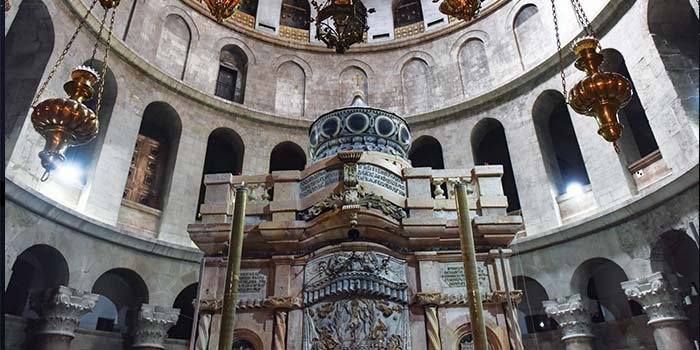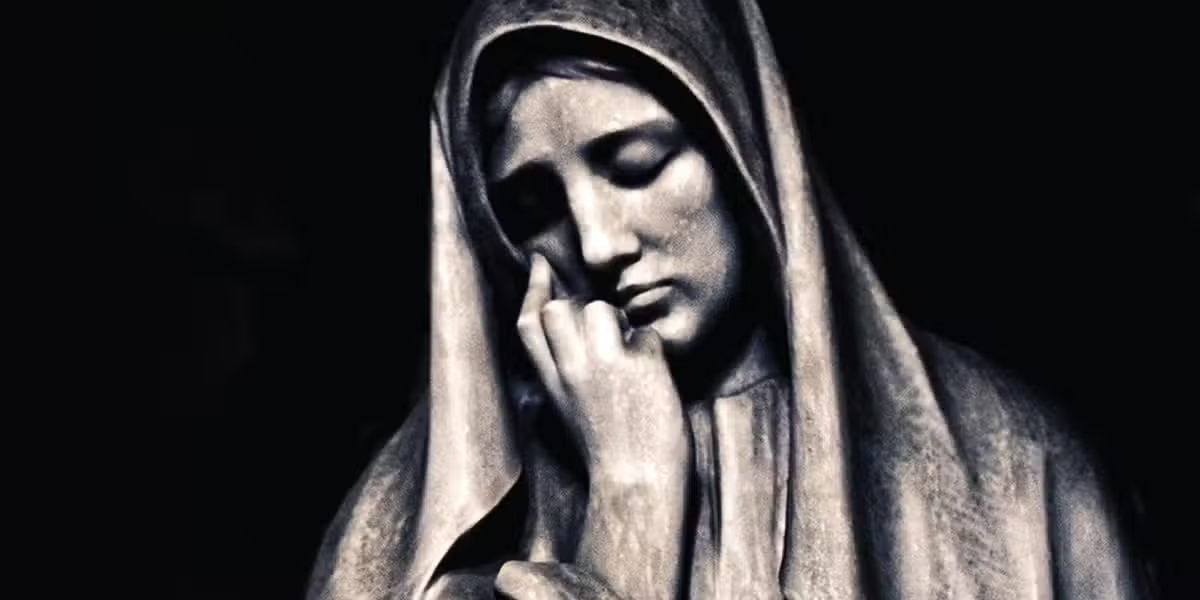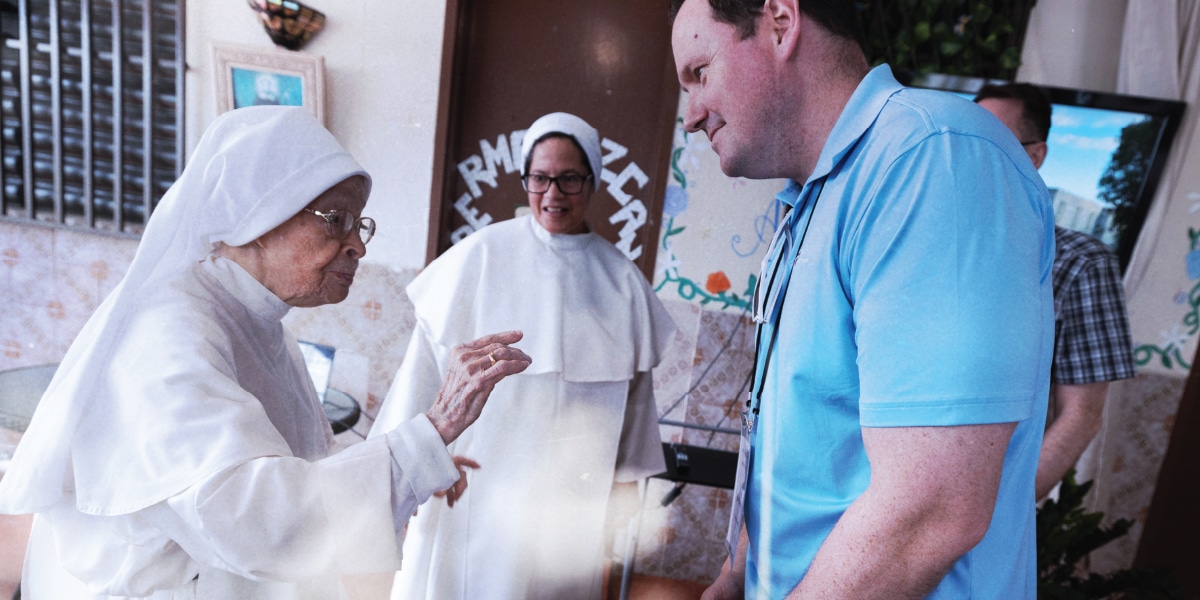The place of Jesus’ burial was in danger until a historic renovation rolled back years of damage and unearthed long-lost frescoes and inscriptions in Jerusalem’s Church of the Holy Sepulchre.
It is the holiest Christian shrine. But, until March 2017, it was in danger of imminent collapse.
The shrine goes by an odd name, the Edicule, meaning “little house.” It sits under a great dome in Jerusalem’s Church of the Holy Sepulchre. No bigger than a good-sized garage, its marble-clad walls are festooned with hanging oil lamps and mismatched candlesticks with bare, energy-efficient lightbulbs. Daily, thousands of visitors line up for hours to see the sacred spot believed to be the burial place of Jesus.
Simply finding one’s way to the Edicule to visit the tomb of Jesus isn’t easy.
On my first visit to the church, I was struck—as many pilgrims are—by a sense of “religious chaos” there. Crowded with both religious pilgrims and casual tourists, the space is divided into a confusing maze of chapels, walkways, and stairs. It is noisy—the hubbub of conversation overlaps with periodic religious songs and ringing bells, as liturgies take place in various parts of the church.
On that visit, our guide stuffed us into a procession of people climbing the small stairway to chapels covering what is left of the rock of Calvary. From Calvary, we descended another staircase, past the “Stone of Anointing,” where it’s believed Jesus’ body lay after his death. The crush of pilgrims moved slowly toward the Edicule.
A Sacred Shrine Endangered
In the past 200-plus years, the Church of the Holy Sepulchre and the Edicule had been ravaged by earthquake, water, and fire. The British overseers of Palestine after World War I had warned the three major Christian communities who serve in the church—the Greek Orthodox, the Latins (Roman Catholics, represented by the Franciscan Friars of the Custody of the Holy Land), and the Armenian Orthodox—that the church would be closed unless they agreed to make it safe for visitors. World War II, the 1948 Arab-Israeli War, and the sometimes contentious negotiations among the communities delayed restoration until the 1950s.
In February 1952, the communities formally agreed to restore and stabilize the dome above the Edicule, a project which, along with other repair work, would take until 1997, when the newly restored and redecorated space was inaugurated with an unprecedented ecumenical ceremony.
But beneath the dome, the Edicule sat unchanged in its iron supports. There was no common agreement on its restoration. During my 2012 visit, I was shocked to see a marble panel literally bulging out from its front wall. Smoke darkened its interior and candle wax marred the exterior. The human impact of millions of visitors had taken its toll. Hidden beneath the marble exterior, serious deterioration threatened the shrine’s stability.
In 2015, the Israeli Antiquities Authority and local police, citing the danger to visitors, ordered the Edicule closed for a few hours each day. This action spurred the three Christian communities to meet and eventually act. Restoration experts from the National Technical University of Athens (NTUA), Greece, assessed the state of the structure.
A Complex History
To understand the problems facing those experts, it’s necessary to understand the complex history of the Edicule and the church in which it stands.
The Gospel stories of Jesus’ crucifixion and burial tell us that he was taken outside the city to Calvary, “the Place of the Skull, in Hebrew, Golgotha” (Jn 19:17). Here, in an abandoned limestone quarry, the Romans executed criminals, raising crosses on the skull-like rock.
After his death, Jesus was buried in a nearby cave offered by Joseph of Arimathea, a follower of Jesus. Wealthy Jews of that time carved tombs in the soft stone walls of the quarry. These tombs sometimes had two chambers—a front area for mourners and an inner chamber with shelves for the bodies of the dead. Today’s Edicule reflects this design.
Christians certainly prayed at the place of Jesus’ resurrection (later incorporated into the city) within the first century. They would have remembered its location even after the Roman Emperor Hadrian covered over the area with tons of rubble and built a pagan temple there.
In the fourth century, the Emperor Constantine approved the removal of the temple and the excavation of the area, uncovering a cave-tomb that was identified by witnesses as that of Jesus. A huge basilica rose over the excavated site, incorporating both the tomb and the rock of Calvary. Within a grand rotunda—called the Anastasis ( “Resurrection”)—a small shrine (the Edicule) was built to protect the tomb itself.
A series of churches and Edicules followed on the spot. These in turn suffered damage and destruction from conquerors, fire, and earthquakes. The present-day Edicule dates only to 1809–1810, when it replaced a structure destroyed by fire.
A Historic Agreement
The team of NTUA experts, led by Professor Antonia Moropoulou, presented their report to the heads of the Christian communities in early 2016. In an interview with St. Anthony Messenger, Professor Moropoulou said: “[It was] after more or less eight months of cooperation and dialogue . . . . But of course, that was not an easy task. It was a great challenge. What was important was that we were empowered by the fact that this environment of dialogue and common trust was a stable ground to go on.”
Using ground-penetrating radar and other noninvasive methods, Professor Moropoulou and her team found that mortar throughout the walls was “susceptible to swelling, dissolution, and degradation.” Up until 1868, a circular opening in the dome above the Edicule allowed rain to pour down on the structure. Moisture was rising through capillary action from water channels and open vaults below the Edicule’s floor. The exterior iron framework, installed by the British in 1948, was deteriorating.
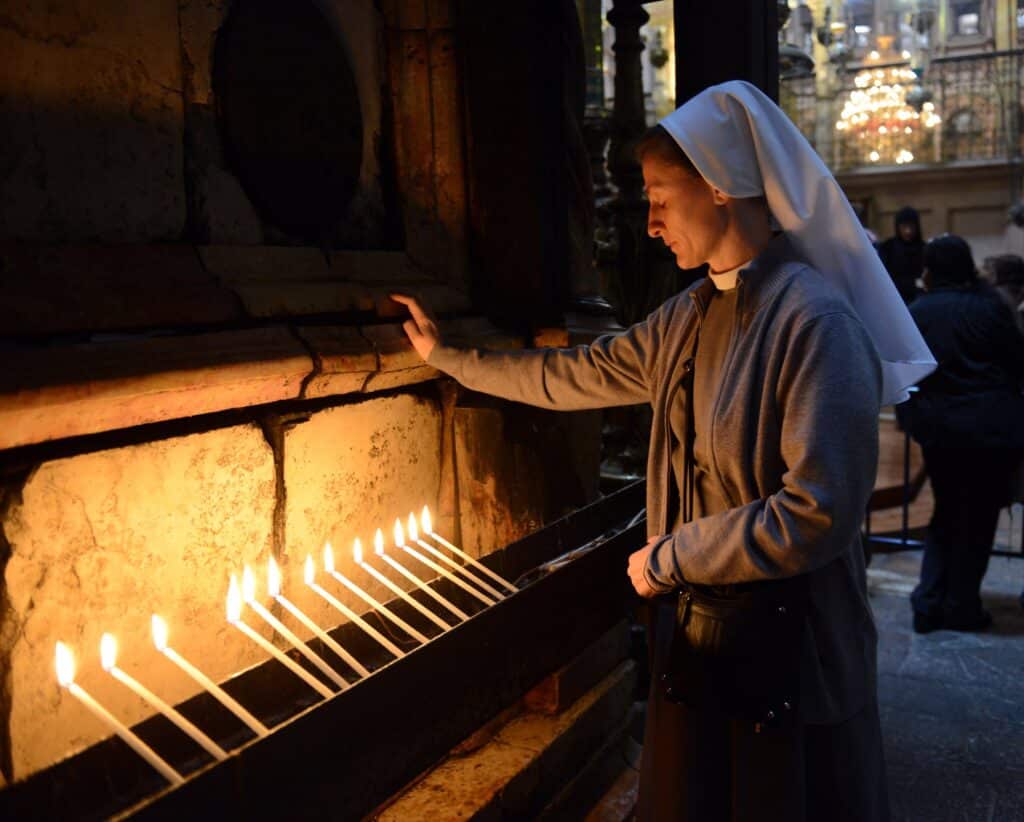
The NTUA team proposed an ambitious plan to:
+ dismantle and remove the stone panels of the Edicule
+ remove all damaged or incompatible mortar
+ repoint the masonry where possible, with injected grouting by a unique process developed by Professor Moropoulou
+ clean all surfaces inside and out
+ stabilize the structure by resetting columns, wall panels, and other elements
+ do conservation work on the dome of the Edicule and interior walls.
The goal of this ambitious plan? Professor Moropoulou says it was “to ensure the structural integrity and to negate the severe deformation . . . [and] to reveal and preserve the values of the Holy Edicule.”
The religious communities were willing to give the go-ahead, but with two conditions.
Fred Hiebert, archaeologist-in-residence at the National Geographic Society (NGS), came to Jerusalem at the invitation of the Greek Orthodox community to observe and document the project. He explained those conditions to St. Anthony Messenger: “The first is that the project could not disturb the Holy Fire [on the Greek Orthodox Easter], so the entire project had to be done between two Easters.
“The second thing, which was even more of a challenge, was that they agreed to carry out the restoration without stopping the pilgrims from going inside. In other words, they couldn’t close the shrine while it was being restored.”
The NTUA’s sophisticated technology, Hiebert contends, was ideal to address the religious communities’ concerns. “To be honest, it sort of blew my mind to see this high technology applied, the same kind of high technology that we use in archaeology: ground-penetrating radar, a laser map that gives you centimeter precision so you know exactly what you’re doing, and thermographic cameras.”
On March 22, 2016, the Greeks, Franciscans, and Armenians held a ceremony in front of the Edicule to mark their agreement. Work began in May and continued around the clock. Behind a temporary barrier, technicians worked while pilgims visited, entering the Edicule through a protected walkway. Marble slabs from the exterior and interior walls were lifted into the second-story gallery of the Franciscans where, in a temporary workshop, restorers could repair and clean them.
As the NTUA team worked, their instruments began to yield mounds of data. Absorbing all that information, Fred Hiebert says, was like “trying to drink from a fire hose. There are so many discoveries that were revealed during the process of architectural conservation. The National Technical University team just didn’t have time to internalize all these new discoveries because we were basically up against a hard deadline. Frescoes got uncovered that had been completely invisible. Inscriptions were found that had been invisible before.”
Hiebert points to one significant find. Between the exterior and interior walls, “two sides of the original cave that scientists and historians have never seen before and have always wondered about” are still present. “It helps—sort of—conclude a centuries-old debate about the actual shape and size of the original cave and the original burial platforms that are inside.”
The ‘Holy Rock’ Revealed
But an even more important revelation came on October 26, 2016. The restoration team needed to open the area venerated as the actual burial place of Jesus. They wanted to install a water barrier to protect the newly restored foundation and walls from future water damage. They asked permission to remove the marble slab over the spot—venerated by centuries of pilgrims. It had been in place since the present Edicule was constructed in 1809.
The communities agreed to close the church for 60 hours, an unprecedented move. There would be no advance notice of when the tomb would be opened. Kristin Romey, staff writer for NGS, told St. Anthony Messenger, “It was a moment that was just so weighted in history . . . and on top of that, there was a whole level of anxiety because the Greeks were very concerned that there would be the potential for a terrorist attack while the tomb was opened, so they would not even tell us the day that it was going to happen. They just said, ‘Be in Jerusalem this week. We’ll give you a couple of hours’ notice. Be prepared to be locked in the church for up to 60 hours.’ That’s the maximum amount of time to have it open.”
A select group of observers from among the Christian communities, with other guests, waited as the marble slab was carefully removed. Below it was a second slab, broken horizontally, and bearing a portion of a carved cross. This second slab had been reported centuries earlier by eyewitnesses. Scholars speculated that it dated from the Crusades, but now it awaited analysis by the Greek team.
Beneath the second slab was original stone, believed to be the resting place of Jesus after the crucifixion. Until this moment, the team had not seen evidence of the rock bed with their ground-penetrating radar.
A Moment of Faith
The Holy Land Review, official publication of the Franciscan Custody of the Holy Land, reported reactions of the Franciscans and their associates who were permitted to view the opened tomb.
Franciscan Father Dobromir Jazstal, vicar of the Custody of the Holy Land, recalled: “It was without any doubt a very moving moment. When the slab was lifted off, everyone was trying to imagine what might be there underneath. We were experiencing something really special, which brought us near to Christ himself.”
Franciscan Father David Grenier, secretary of the Custody of the Holy Land, observed the emotions of those present. “I saw all those who went in and I saw them come out. One after the other, their eyes were shining with tears, filled with emotion.”
Osama Hamdan, architect for the Franciscan Custody of the Holy Land, brought a different viewpoint: “I am a Muslim, and Jesus is a prophet for us. To work at the tomb of Jesus—it’s really emotional. To be here, at this exact moment, I felt very privileged. The Sepulchre is part of the places that are also venerated by Muslims. It has a great religious and historical value.”
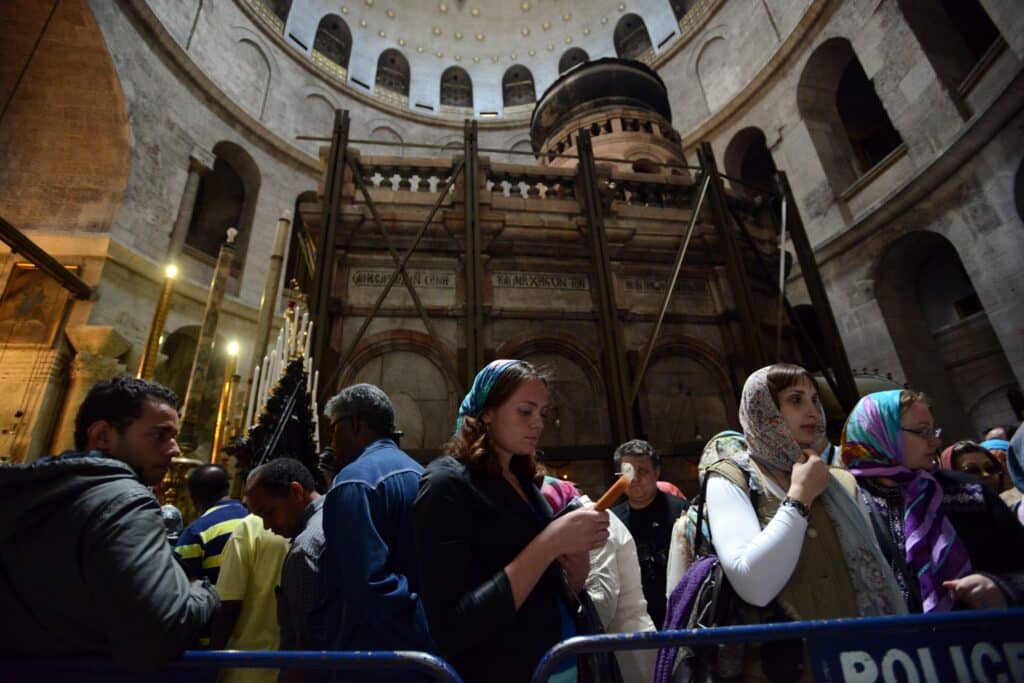
While some would have wished to make a more thorough examination of the burial place of Jesus, the deadline of Orthodox Easter 2017 loomed. The opening was sealed and work continued. But measurements taken while it was exposed would offer one further surprise. Samples examined using archaeometric investigation revealed that mortar holding the lower slab to the bedrock dates to AD 345, plus or minus 165 years. This means that the lower slab (thought to be more recent) comes from the Constantinian era.
More revelations will certainly come as the mountain of data is studied and released, something Professor Moropoulou promises future generations. One concession to the future came as the team was permitted to open a window in the inner wall of the tomb chamber, opposite the burial place of Jesus. A Plexiglas cover will permit future monitoring of the original stone of the cave. And this “window into time” will offer an opportunity for pilgrims to view the Holy Rock that witnessed the Resurrection.
Greg Friedman, OFM, is a Franciscan friar in service to the Franciscans of the Holy Land and editor of The Holy Land Review. Marie-Armelle Beaulieu and Beatrice Guarrera of Terre Sainte Magazine contributed to the reporting for this article.
The Silent Witness: An Easter Reflection
We waited with a sense of great anticipation on the night of October 26, 2016, as inside the Edicule enshrining the tomb of Jesus in Jerusalem’s Church of the Holy Sepulchre, engineers under the supervision of the National Technical University of Athens prepared to expose something that had been seen by no living creature. The marble slab covering the burial site of Jesus, in place since 1555 and not opened since 1809, was about to be removed.
The sense of awe at being present for such a historic occasion was broken only by the occasional nervous chatter of the Greek Orthodox monks, the Franciscans (representing the Catholic Church), and Armenian Orthodox.
Would the tomb reveal anything? Would this be somewhat akin to those occasions when a long-lost safe, retrieved from the depths of the ocean and now primed to reveal its secrets, disappointed? A la Hollywood, would the earth shudder? Would a voice from deep within boom out, “This is holy ground! This far and no farther!”? Would sparks emerge? A lightning bolt, perhaps?
Yet everyone was quiet when the official representatives of those three Churches emerged to say that, for the moment, all that was visible underneath the now-removed slab was a kind of filling of unknown origin.
As the hours wore on into the next day, it was with excitement that we received the news that, with the filling carefully removed, the tomb revealed yet another marble slab with a cross, and underneath that, a portion of the rock on which Jesus’ body had lain. (Previously, scholars had doubted that any part of the rock could have remained, given the ravages of time and the deliberate destruction of the area in 1009 by the Fatimids.)
But there it was. Whenever pauses in the work permitted, we were able to enter, and experience the once-in-a-lifetime privilege of seeing and touching the holy rock. It was here in this place that the greatest event in the history of humanity occurred more than 2,000 years ago, when sin and death were conquered by the raising of Jesus from the dead.
How I wanted that rock to speak!
But the rock remained silent. It continues to keep its silent watch just as it has done for all these years.
Now, any time that I enter the Edicule, whether it be to celebrate the Eucharist or to incense the tomb on other occasions, I always take the time and look toward that portion of the cave wall on the southern side, where now a narrow window that was exposed during the course of the recent work offers a view of a section of the rock.
I want to say to it, “Speak. What was it like to have seen and received the broken and bruised body of your Creator? How did it feel to have supported and held it, as if you could have wrapped your arms around it to offer comfort on that Good Friday evening, and then to have looked on in sheer amazement as he rose from the dead on Easter Sunday morning?”
In its silence, it looks back at me as if to say, “Now you tell what you have seen and heard. He is not here! He is risen. Alleluia!”
Franciscan Father Fergus Clarke serves with the friars of the Custody of the Holy Land at the Church of the Holy Sepulchre in Jerusalem.
The Work That Remains
The NTUA team completed their work in time for the celebrations of Easter in the Holy Sepulchre in April 2017. Now that the Edicule is clean and stable for the first time in nearly two centuries, its safety is assured for the foreseeable future.
But the team, led by Professor Moropoulou, tempers that assurance with a warning. The floor beneath the rotunda is itself threatened. Open vaults and numerous water chambers collect rainwater and sewage. The same process of deterioration that threatened the Edicule now bodes an uncertain future for the Anastasis itself and thus with it, the Edicule.
The NTUA team has offered a plan to the Christian communities to eliminate this threat. But the communities, cautious of disrupting the daily flow of pilgrims and the conduct of daily rituals, have yet to act.
Time inside the Church of the Holy Sepulchre proceeds according to the demands of faith, worship, and ancient customs. And yet, over the centuries, the world outside has intervened into the chronology of salvation—most often in a destructive way. The project to restore the Edicule has been historic, in its positive outcomes, thanks to the cooperation of the Christian communities (photo above). The encounter of science and faith offers hope for this holiest of Christian shrines.


